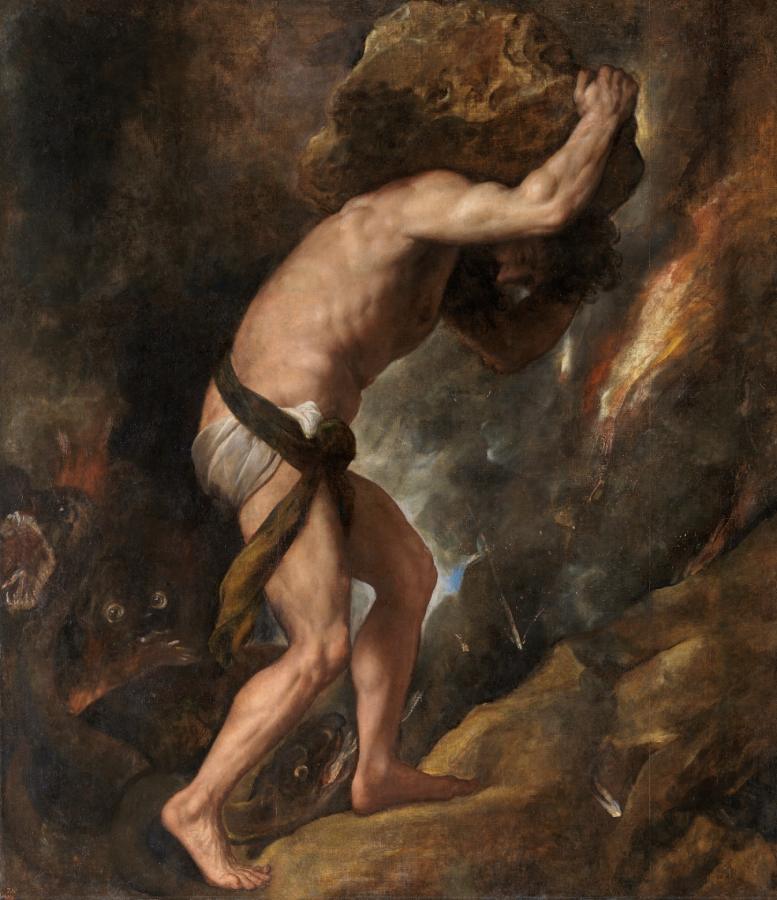Tiziano (c.1488-1576)
Sisifo (Sisyphus)
1548–1549
Oil on canvas, 237 x 216 cm
Museo del Prado, Madrid
The literary source for the Furies is Ovid‘s Metamorphoses (IV, 447-464) and Virgil‘s Aeneid (VI, 457-8), which recounts the eternal sufferings in Hades of Tityus, whose liver was devoured by a vulture as a punishment for having raped Latona; Tantalus, condemned to try to reach food and drink in vain for having killed and cooked his son Pelops as a banquet for the gods; Sisyphus, founder and king of Corinth, obliged to push a rock for ever uphill for having recounted Zeus’ affair with Egina; and Ixion, who had tried to seduce Juno, for which he was forever condemned to turn on an endless wheel. The choice of such unusual subject-matter -up to that point Titian‘s commissions from the Habsburgs were all portraits- lies with Mary of Hungary (1505-1558), and her intentions are clear when the works hung in their original locations. On 22 August 1549 the Great Room in the Palace of Binche was inaugurated, the decoration of which is known through documentary sources. The paintings were hung high up between large windows, while the lengthy description provided by Calvete de Estrella (1552) indicates the coherence of an iconographic programme whose main idea was to emphasise the misery and endless punishment of those who rise up against the gods. In a setting filled with classical references, the Tityus and Sisyphus by Titian and the Tantalus by Coxcie occupied one long side of the room, opposite a series of tapestries with the victory of the Virtues over the Vices (avarice again represented by Tantalus). On the end walls were medallions of Hadrian and Julius Caesar, and above them paintings by Coxcie with the competition between Apollo and Marsyas and the later flaying of the satyr. Emphasising this idea, the room also contained representations of the giant Enceladus burned by Zeus, of Phaeton and Plegias, father of Ixion, condemned to hell for having burned the temple of Apollo in Delphi, accompanied by related inscriptions. With the paintings of the Furies, commissioned in Augsburg after the Battle of Mühlberg, Mary intended to show the destiny of those who rise up against their legitimate ruler, clothing her message in mythological guise and comparing the challenge to the gods with that of the German princes to the emperor. The way in which these episodes are represented reveals the use of elements from Christian iconography translated into the mythological realm. To visualise Hades, Titian used fire -and in the case of Sisyphus two enormous monsters whose open jaws directly recall images of the Last Judgement- while the negative character of the various figures is suggested by the presence of serpents, elements not found in Ovid and also present in the print of Tantalus. The Furies are inconceivable without Titian‘s Roman experience. While there had been a copy of the Hellenistic sculpture known as the Gauls or Galatians in Venice since at least 1523 and which the lost Tantalus is based on, it is only after 1546 that we can detect in Titian‘s work a satisfactory blend of classical statuary and the art of Michelangelo. As in the contemporary paintings for Santo Spirito in Isola (now in Santa Maria della Salute, Venice), or the Vision of Saint John the Evangelist (Washington, National Gallery), which uses the same devises of looking down on the figures from above found in the Furies, we see Titian using figures with monumental anatomy, often nude, and which create the space around them, rather than vice versa. What is interesting is that despite these sources, Titian‘s use of colour produced works that were very different in character. Sisyphus is the best example, as in contrast to the Tityus, the feeling of dynamism is not just limited to the body, but is also evident in the vibrant tongues of flame and lava which fall from the mountain peak, represented with dense brushstrokes of red and yellow. The Furies remained in Binche until the palace was destroyed by French troops in 1554. In 1558 Mary of Hungary bequeathed them to Philip II who sent them to the Alcazar in Madrid, where in 1566 the poet Juan de Mal Lara composed four Latin verses and an octave for each one. They remained there until the fire of 1734 in which the Ixion and Tantalus were destroyed. After a brief period in the Buen Retiro, where they are mentioned in 1747, they hung in the ante-room of the Palacio Real Nuevo until they entered the Museo del Prado in 1828. (Falomir Faus, Miguel, Tiziano, Madrid, Museo Nacional del Prado, 2003, p.214)
See also:
• Ovid (43 BC-17/18 AD): The Metamorphoses (English) | Vergilius Maro, Publius (70 BC-19 BC): The Aeneid (English)
